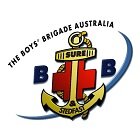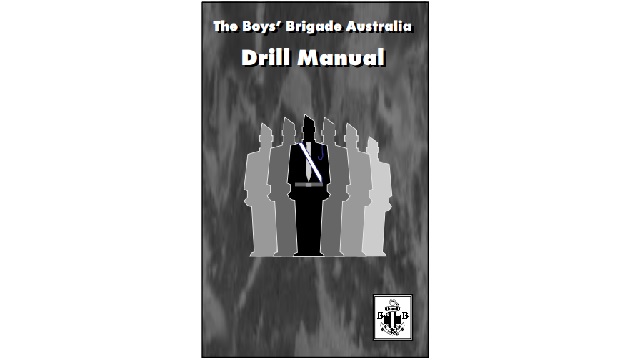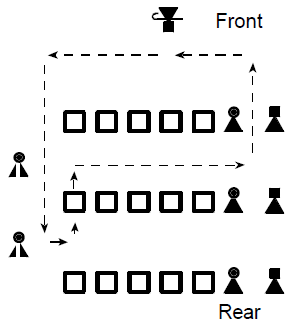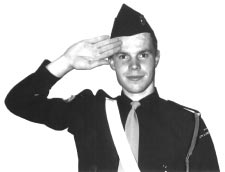Following are the basic drill movement a boy should know as he moves through the section of BB.
1. Basic Positions
(a) Attention ATTEN—SHUN

Heels together and in line; feet turned out at an angle of thirty degrees; legs straight; body erect and square to the front; arms hanging easily and as straight as the natural bend of the arm will allow; wrists straight, hands clenched, knuckles outside; thumbs to the front, close to the forefinger, and immediately behind the seams of the trousers; head and eyes facing the front; eyes looking at their own level; the weight of the body equally balanced on both feet. The position is one of readiness in expectation of further commands.
 (b) Stand at Ease from Attention STAND AT—EASE
(b) Stand at Ease from Attention STAND AT—EASE
Keeping the legs straight, the left foot is moved 15cm (6 inches), measured from heel to heel, directly to the left so that the weight of the body rests equally on both feet; at the same time, the hands are placed behind the back, with the arms fully extended, the back of the right hand placed in the palm of the left, with fingers of both hands straight, and thumbs crossed.
NB Although this position is more relaxed than that of Attention, no movement is to be made.
(c) Stand Easy from Stand at Ease STAND—EASY
The limbs, head and body may be moved, but not the feet, so that there will be no loss of dressing when coming to attention.
NB 1. When standing easy, and the command “SQUAD” is given, the position of Stand at Ease is assumed.
2. When coming to attention from the Stand at Ease position, keeping the leg straight the left foot is brought up to the right without stamping, and the position of Attention is assumed.
 2. Turning at the Halt RIGHT TURN
2. Turning at the Halt RIGHT TURN
Keeping both knees straight and the body erect, a turn is made to the right on the right heel and left toe, the left heel and right toe being raised in doing so, and the arms being kept close to the side. On completion of this preliminary movement the right foot must be flat on the ground, the left heel raised, both knees straight, the weight of the body (which must be erect) on the right foot.
The left heel is brought smartly up to the right without stamping the foot, to resume the position of attention.
3. Falling Out FALL—OUT
The unit turns to the right and remains at attention for a pause equal to four paces in quick time and then breaks off quietly.
 4. Leaving and Returning to the Ranks
4. Leaving and Returning to the Ranks
There are occasions when a Boy is ordered to leave the ranks by the OC Parade, e.g. Private Bloggs, FALL—OUT.
The nominated Boy comes to attention, takes a pace to the front, pauses, then marches directly to the OC (if not in the front rank, via the right of the Squad) and halts two paces from him, faces him, salutes and is told what to do. He will salute again then turn before marching off to carry out the particular duty. On his return he will wait to be told to take his place, march to the rear of his rank from the left of the Squad to the vacant spot and halt. He will adopt the same position as other members.
5. Marching in Slow Time
(a) Slow March SLOW—MARCH
The left foot is advanced keeping it at the same angle as it was at attention. The toe points downwards and comes first to the ground. A full pace of 60cm (24 inches) is taken without checking the forward leg movement, the weight of the body is brought on to the left foot, then the right foot is advanced in the same manner, and the forward movement continued. The time is sixty paces to the minute. Arms are kept still at the side.
(b) Halt SQUAD—HALT
The word “halt” is given on the right foot. A pace of 60cm (24 inches) is then taken with the left foot (check pace), and the right foot brought up in line with it, without stamping, in the same time as slow march.
6. Marching in Quick Time
(a) Quick March QUICK—MARCH
Commencing with the left foot, a pace of 60cm (24 inches) is taken. Care should be taken to see that the first pace is a full one. Without bending the elbow the right arm is swung forward from the shoulder as the left foot advances. The hand is not raised higher than the waist-belt nor in advance of the leading foot nor swung across the body; the left arm is swung back as far as possible.
The forward movement is continued in quick time. The time is 120 paces to the minute.
(b) Halt SQUAD—HALT
The command is given and the movement executed as detailed in 5 (b) above, except that when the right foot is brought forward on completion of the movement, both hands are brought smartly to the side.
7. Changing Time
(a) Marching in Quick Time—From the slow march
BREAK INTO QUICK TIME, QUICK—MARCH
The command “March” is given as the left foot comes to the ground. A pace in slow time will be taken with the right foot (check pace) and the left foot will move forward for the first pace in quick time. The arms, which have been steady during the slow march, will commence swinging with the
left foot.
(b) Marching in Slow Time—From the quick march
BREAK INTO SLOW TIME, SLOW—MARCH
The command is given as the left foot comes to the ground. A pace in quick time will be taken with the right foot (check pace) and the left foot will move forward for the first pace in slow time, the arms being steadied at the side.
8. Turning on the March
(a) Right Turn RIGHT—TURN
The command is given on the left foot. A pace is taken with the right foot (check pace), and the arms cut to the side when in quick time, the left knee bent. The body is turned through 90 degrees to the right and the left foot placed down with the ball of the foot immediately in front of the right toe – forming a ‘T’. With the right foot, a full pace in the new direction is made and, in quick time, the arms commence swinging again with the pace forward.
(b) Left Turn
When turning to the left on the march, the detail is the same as 8 (a) above, except that the word left is substituted for the word right, and vice versa.
(c) Inclining
This movement is carried out in the same manner as for a turn on the march, except that the turn will be half right or left.
(d) About Turn ABOUT—TURN
The command is given on the left foot. A pace forward is taken with the right foot (check pace).
The body is then turned about to the right by marking time for three beats, turning the body progressively with each beat. The feet forming ‘T’, ‘L’, and ‘V’ corresponding to the three beats.
The movement forward is commenced with the right foot. During the three beats the arms are kept steady at the side. In quick time, the arms commence swinging again with the pace forward.
9. Marking Time
(a) Slow Mark Time SLOW MARK—TIME
Commencing with the left foot, the feet are raised alternately 23cm (9 inches) from the ground; knees to the front, heels kept under the knees, body steady and arms still at the side. The time is 60 paces to the minute.
(b) Halt SQUAD—HALT
The command is given and the movement executed as when marching.
(c) Quick Mark Time QUICK MARK—TIME
Commencing with the left foot, the feet are raised alternately about 15cm (6 inches) from the ground; knees to the front, heels kept under the knees, body steady, and arms still at the side. The time is 120 paces to the minute.
(d) Halt SQUAD—HALT
The command is given and the movement executed as when marching, except that the hands are already steady at the side.
(e) Marking Time from Marching MARK—TIME
The command is given on the left foot. A further pace is taken with the right foot (check pace) and the marking time commences with the left foot. The arms, which have been swinging during the marching, are brought smartly to the side, on the check pace.
(f) Moving forward from Marking Time FOR—WARD
The command is given on the left foot, and after one more step with the right foot (check pace) the march commences with a full pace forward with the left foot. The arms, which have been still during the marking time, commence swinging with the left foot.
This detail applies also to slow time, except that the arms remain steady by the side.
(g) Turning about when Marking Time ABOUT—TURN
The command is given and turn executed as in 8 (d) on page 4.4, except the check pace is a mark time pace. Marking time continues until a further command is given, e.g. FOR—WARD or HALT.
10.Stepping Forward, Back and to the Side
(a) Stepping Forward —PACES STEP FORWARD—MARCH
Commencing with the left foot successive paces of 60cm (24 inches) are taken straight to the front.
Arms remain steady at the side. In halting, the rear foot is brought up to the front one. Any irregularity of dressing occurring during the movement is immediately corrected without word of command. Stepping forward should not exceed six paces. Movements are made in quick time.
(b) Stepping Back —PACES STEP BACK—MARCH
Commencing with the left foot successive paces of 60cm (24 inches) are taken straight to the rear.
Arms remain steady at the side. In halting, the front foot is brought up to the rear foot. Any irregularity of dressing occurring during the movement is immediately corrected without word of command. Stepping back should not exceed six paces. Movements are made in quick time.
(c) Stepping to the Side —PACES RIGHT CLOSE—MARCH
The right foot is placed 15cm (6 inches) directly to the right and the left foot is brought up to it.
The necessary number of paces are completed in this manner without a pause. Any irregularity of dressing occurring during the movement is immediately corrected without word of command.
Stepping to the side should not exceed six paces. The time is sixty completed side-step paces to the minute, each foot moving at the same speed.
11.Changing Step CHANGE—STEP
The command is given on the left foot. A check pace is taken with the right foot and on the next pace with the left foot, the hollow of the instep of the right foot is brought up to the heel of the left and immediately a further pace is taken with the left foot. These two last paces are taken in the time of one normal pace.
 12.Saluting
12.Saluting
The salute is always executed with the right hand.
(a) Saluting to the front
(i) By numbers
SALUTE TO THE FRONT BY NUMBERS—ONE
On the word “one” the right hand is brought smartly with a circular motion to the head, palm to the front, fingers extended and close together, point of the forefinger touching the forehead 25 mm (one inch) above the right eye, thumb close to the forefinger, tips of the fingers, wrist and elbow in a straight line.
—TWO
On “two”, the hand is brought by the shortest route to the side without striking the leg, lightly clenching the hand on the way down.
(ii) Counting the time
SALUTE TO THE FRONT COUNTING THE TIME—SALUTE
The movement is exactly the same as in saluting by numbers but Boys should be taught to count numbers aloud until they get used to the time. The count is: One—raise hand to forehead. Two. Three—hold hand in position. Four—lower hand.
(iii) Judging the time
SALUTE TO THE FRONT—SALUTE
The movements are exactly the same as in 12 (a) (ii) above, but neither Instructor nor Boys count aloud.
(b) Saluting to the side
SALUTE TO THE RIGHT (OR LEFT)—SALUTE
The procedure is as described above, except that as the hand is brought to the salute, the head is turned towards the person being saluted. The position of the hand will be so adjusted that the point of the forefinger will be 25mm above the right eye.
(c) Dismissing
DIS—MISS
Boys turn to the right, salute with the right hand, and after a pause equal to four paces in quick time break off quietly. The head is not turned in the direction of the Officer during the salute.
When instructing Boys on dismissing it should be practised by numbers, as follow: One, Pause, Two —turn to the right
Pause —remain steady
One —salute
Two, Three —remain at the salute
Four —cut away hand to side
One, Two, Three, Four —remain steady
Five —break off quietly.
NB If the unit is being dismissed by a Staff-Sergeant or Non-Commissioned Officer, the command
“Fall—OUT” will be given.


 (b) Stand at Ease from Attention STAND AT—EASE
(b) Stand at Ease from Attention STAND AT—EASE 2. Turning at the Halt RIGHT TURN
2. Turning at the Halt RIGHT TURN 4. Leaving and Returning to the Ranks
4. Leaving and Returning to the Ranks 12.Saluting
12.Saluting